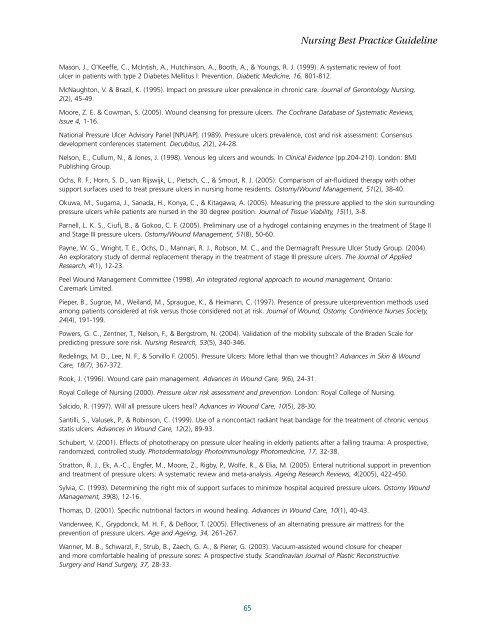RNAO BPG Pressure Ulcers Stage I to IV - Faculty of Health ...
RNAO BPG Pressure Ulcers Stage I to IV - Faculty of Health ...
RNAO BPG Pressure Ulcers Stage I to IV - Faculty of Health ...
You also want an ePaper? Increase the reach of your titles
YUMPU automatically turns print PDFs into web optimized ePapers that Google loves.
Nursing Best Practice GuidelineMason, J., O’Keeffe, C., McIntish, A., Hutchinson, A., Booth, A., & Youngs, R. J. (1999). A systematic review <strong>of</strong> footulcer in patients with type 2 Diabetes Mellitus I: Prevention. Diabetic Medicine, 16, 801-812.McNaugh<strong>to</strong>n, V. & Brazil, K. (1995). Impact on pressure ulcer prevalence in chronic care. Journal <strong>of</strong> Geron<strong>to</strong>logy Nursing,2(2), 45-49.Moore, Z. E. & Cowman, S. (2005). Wound cleansing for pressure ulcers. The Cochrane Database <strong>of</strong> Systematic Reviews,Issue 4, 1-16.National <strong>Pressure</strong> Ulcer Advisory Panel [NPUAP]. (1989). <strong>Pressure</strong> ulcers prevalence, cost and risk assessment: Consensusdevelopment conferences statement. Decubitus, 2(2), 24-28.Nelson, E., Cullum, N., & Jones, J. (1998). Venous leg ulcers and wounds. In Clinical Evidence (pp.204-210). London: BMJPublishing Group.Ochs, R. F., Horn, S. D., van Rijswijk, L., Pietsch, C., & Smout, R. J. (2005). Comparison <strong>of</strong> air-fluidized therapy with othersupport surfaces used <strong>to</strong> treat pressure ulcers in nursing home residents. Os<strong>to</strong>my/Wound Management, 51(2), 38-40.Okuwa, M., Sugama, J., Sanada, H., Konya, C., & Kitagawa, A. (2005). Measuring the pressure applied <strong>to</strong> the skin surroundingpressure ulcers while patients are nursed in the 30 degree position. Journal <strong>of</strong> Tissue Viability, 15(1), 3-8.Parnell, L. K. S., Ciufi, B., & Gokoo, C. F. (2005). Preliminary use <strong>of</strong> a hydrogel containing enzymes in the treatment <strong>of</strong> <strong>Stage</strong> IIand <strong>Stage</strong> III pressure ulcers. Os<strong>to</strong>my/Wound Management, 51(8), 50-60.Payne, W. G., Wright, T. E., Ochs, D., Mannari, R. J., Robson, M. C., and the Dermagraft <strong>Pressure</strong> Ulcer Study Group. (2004).An explora<strong>to</strong>ry study <strong>of</strong> dermal replacement therapy in the treatment <strong>of</strong> stage III pressure ulcers. The Journal <strong>of</strong> AppliedResearch, 4(1), 12-23.Peel Wound Management Committee (1998). An integrated regional approach <strong>to</strong> wound management, Ontario:Caremark Limited.Pieper, B., Sugrue, M., Weiland, M., Spraugue, K., & Heimann, C. (1997). Presence <strong>of</strong> pressure ulcerprevention methods usedamong patients considered at risk versus those considered not at risk. Journal <strong>of</strong> Wound, Os<strong>to</strong>my, Continence Nurses Society,24(4), 191-199.Powers, G. C., Zentner, T., Nelson, F., & Bergstrom, N. (2004). Validation <strong>of</strong> the mobility subscale <strong>of</strong> the Braden Scale forpredicting pressure sore risk. Nursing Research, 53(5), 340-346.Redelings, M. D., Lee, N. F., & Sorvillo F. (2005). <strong>Pressure</strong> <strong>Ulcers</strong>: More lethal than we thought? Advances in Skin & WoundCare, 18(7), 367-372.Rook, J. (1996). Wound care pain management. Advances in Wound Care, 9(6), 24-31.Royal College <strong>of</strong> Nursing (2000). <strong>Pressure</strong> ulcer risk assessment and prevention. London: Royal College <strong>of</strong> Nursing.Salcido, R. (1997). Will all pressure ulcers heal? Advances in Wound Care, 10(5), 28-30.Santilli, S., Valusek, P., & Robinson, C. (1999). Use <strong>of</strong> a noncontact radiant heat bandage for the treatment <strong>of</strong> chronic venousstatis ulcers. Advances in Wound Care, 12(2), 89-93.Schubert, V. (2001). Effects <strong>of</strong> pho<strong>to</strong>therapy on pressure ulcer healing in elderly patients after a falling trauma: A prospective,randomized, controlled study. Pho<strong>to</strong>derma<strong>to</strong>logy Pho<strong>to</strong>immunology Pho<strong>to</strong>medicine, 17, 32-38.Strat<strong>to</strong>n, R. J., Ek, A.-C., Engfer, M., Moore, Z., Rigby, P., Wolfe, R., & Elia, M. (2005). Enteral nutritional support in preventionand treatment <strong>of</strong> pressure ulcers: A systematic review and meta-analysis. Ageing Research Reviews, 4(2005), 422-450.Sylvia, C. (1993). Determining the right mix <strong>of</strong> support surfaces <strong>to</strong> minimize hospital acquired pressure ulcers. Os<strong>to</strong>my WoundManagement, 39(8), 12-16.Thomas, D. (2001). Specific nutritional fac<strong>to</strong>rs in wound healing. Advances in Wound Care, 10(1), 40-43.Vanderwee, K., Grypdonck, M. H. F., & Defloor, T. (2005). Effectiveness <strong>of</strong> an alternating pressure air mattress for theprevention <strong>of</strong> pressure ulcers. Age and Ageing, 34, 261-267.Wanner, M. B., Schwarzl, F., Strub, B., Zaech, G. A., & Pierer, G. (2003). Vacuum-assisted wound closure for cheaperand more comfortable healing <strong>of</strong> pressure sores: A prospective study. Scandinavian Journal <strong>of</strong> Plastic ReconstructiveSurgery and Hand Surgery, 37, 28-33.65
















